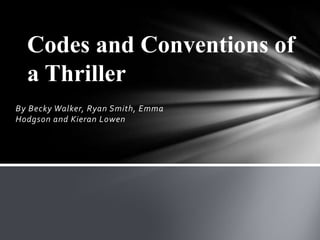
Codes and conventions of a thriller
- 1. Codes and Conventions of a Thriller By Becky Walker, Ryan Smith, Emma Hodgson and Kieran Lowen
- 2. What is a Thriller? A thriller is a genre that uses suspense, tension and excitement as it’s main elements. A lot of the time thriller uses enigma to capture an audiences attention. There are different kinds of elements to a thriller genre, for example; Thematic, Narrative, and Technical.
- 3. Thriller Elements Thematic Elements- Thrillers are meant to be enigmatic, tension- creating and exciting. They promote moods, For example; a high level of anticipation, adrenaline rush, arousal, uncertainty and sometimes even terror. Narrative Elements- Thrillers have literary devices like plot twists, ret herrings and cliff- hangers. Usually narrative elements show society as a corrupted and dangerous place that has violence, crime and murder with a menacing atmosphere. Technical Elements- The thriller genre usually has quick cuts, elliptical (invisible) editing, change in camera angles. Music is often there to create tension but again, it depends on which sub- genre the movie lies in. Also lighting, shadows, mirrors, flashbacks, twists, stairs and surprises depends on the sub-genre of the movie and how it will effect it.
- 4. Mise-en-scene Props- Fake blood, weapons (knives, guns, axes, chainsaws), lanterns etc… Costumes- Ripped clothes, dark colours, masks, make up. Lighting- Dark light, dull, gloomy, mysterious, low/high key. Setting and location- Train tracks, woods, old mental homes, abandoned houses, fields. NVC- The use of non verbal communication builds up tension by the use of silence and expression on peoples faces.
- 5. Sound The sound to a thriller movie would be incidental sound where the movie fits with the action. You would usually hear loud screeching and screaming to make the film more mysterious and get us thinking to what is going to happen next. The use of silence is a powerful tool to suggest fear or menace.
- 6. Editing -Only use fade to connect the scenes together. -Don’t use transitions as it looks scruffy, just use basic cuts. -The use of shallow focus can establish the importance of an object so can be used to show the importance of a main fixture in the film. -Continuity editing should be used to give a sense of realism and flows together.
- 7. Narrative structure Narrative Structure of a thriller: Inciting Incident (Builds the story) Progressive Complications (Things get worse) Crisis Climax Resolution
- 8. Camera shots Close ups –To show how someone is feeling or on an important object in the scene. Extreme Close up – To show a closer view of an emotion. Shallow focus – Blurs out the background and just focuses on one thing, can use this to show the importance of an object. High angle shot- To show the power of someone. Low angle shot – To show the weakness of someone. Tracking shot – Following the victim and the antagonist. This link with steadi-cam and hand held cameras to give a sense of realism Wide shot – To show how alone the victim is. Establishing shot –To show the audience where it is set.
- 9. Composition Composition is where a character or an object is placed on the scene, for example the use of rule of thirds is where an object/character is placed in an imaginary grid to show the importance of a scene. The photo should be divided into nine equal parts, these parts then create more tension, energy and interest in the composition rather than placing a character directly in the middle. In typical media films the main character is placed in the middle to draw the audiences attention to the centre. Composition is a key factor to a good film as an oddly placed character or object could ruin the film buy being out of place and not needed in the scene.
- 10. Antagonist and Protagonist An antagonist is a character, group of characters, or institution, that represents the opposition against which the protagonist must contend. In other words, 'A person, or a group of people who face the protagonist, or most of the time the main characters.' In the classic style of stories wherein action films it consists of a hero fighting a villain/enemy, the two can be regarded as protagonist and antagonist, respectively. The antagonist may also represent a major threat or obstacle to the main character by their very existence, without necessarily deliberately targeting him or her. The antagonist would usually be looking for trouble as he/she would try to disrupt society or to hurt certain people. A protagonist is the main character (the central or primary personal figure) of a literary, theatrical, cinematic, or musical narrative, which ends up in conflict because of the antagonist and whom the audience is intended to most identify with. In a film the protagonists are usually scared and trying to solve a crime to catch the antagonist.